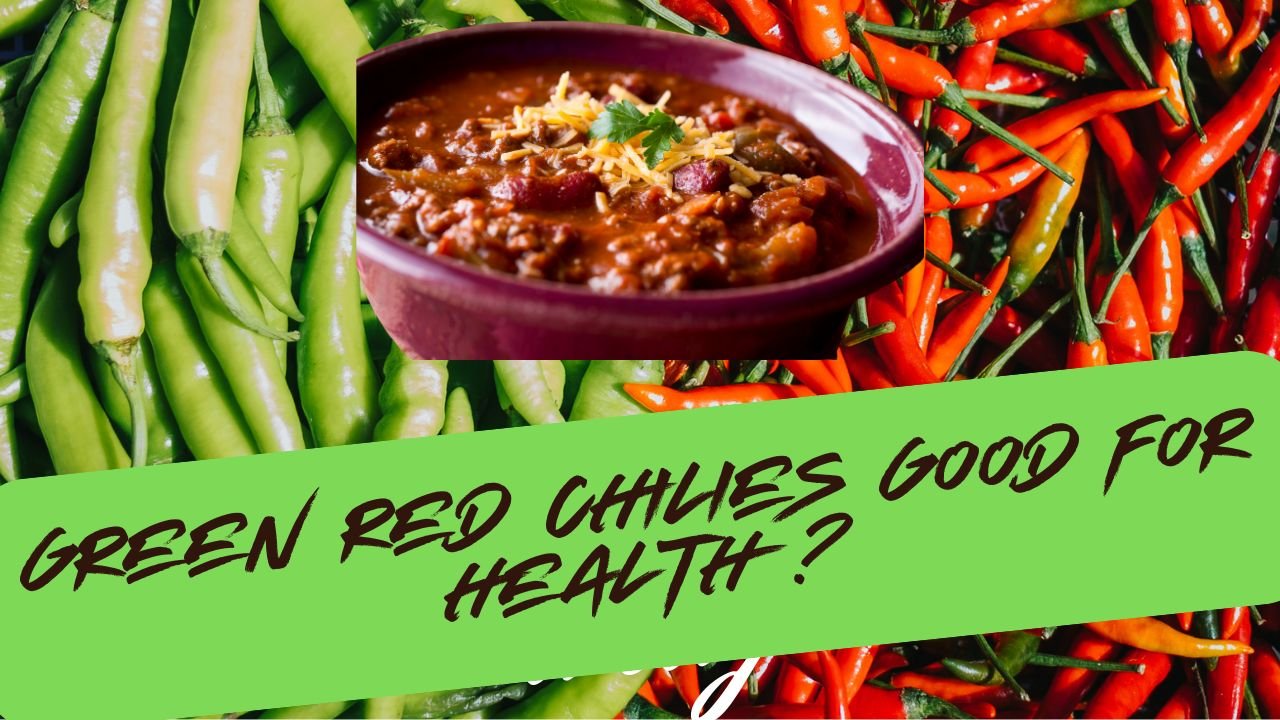Are Green and Red Chilies Good for Your Health?
Have you been using green and red chilies in your lunch or dinner. Explore what they provide you and when to avoid.
Yes—they are healthy if you eat them in small amounts.
🌶️ What’s the Difference Between Green and Red Chilies?
-
Green chilies are picked before fully ripe. They taste fresh, are usually thinner and sharper in flavor.
-
Red chilies are ripe and left on the plant longer. They are often hotter, sweeter, and richer in antioxidants and vitamin A.
🚀 Health Benefits of Green Chilies

-
Zero calories but rich in vitamins—often much more vitamin C per gram, plus vitamins A, B6, and minerals like potassium and iron
-
Boost metabolism and weight loss—capsaicin in green chili speeds up metabolism, burns fat.
-
Promote digestion—good fiber and gut‑friendly. Helps ease constipation.
-
Balance blood sugar levels—regular small amounts may help manage insulin and prevent spikes.
-
Support heart and skin health—beta‑carotene and antioxidants for strong heart, glowing skin.
-
Anti‑inflammatory, natural pain relief—capsaicin helps reduce inflammation and joint discomfort.
❤️ Health Benefits of Red Chilies

-
Very high in vitamin C and beta‑carotene (vitamin A) to boost immunity and protect against infection and oxidative damage.
-
Iron absorption support—vitamin C in red chilies helps absorb iron, which is good if you have anemia.
-
May reduce chronic disease risk—capsaicin may improve blood pressure, cholesterol, and reduce inflammation.
-
Possible longer life—one study found red chile eaters had a 13% reduced death risk over two decades.
⚠️ Possible Side Effects or Consequences
-
Upset stomach, heartburn, reflux—capsaicin may irritate if you’re sensitive or have ulcers.
-
Loose stools or urgency—spicy food speeds up digestion, which some find uncomfortable.
-
Skin or allergy reactions—some people react to nightshade family foods like chilies.
-
Too much heat—very spicy chilies can overwhelm some; start with small amounts and build tolerance.
🍳 Should You Use Fried Chilies?
-
Frying chilies (e.g. chili oil or frying in oil) does not destroy all nutrients, but:
-
It adds extra calories and fat.
-
Some vitamin C may reduce with high heat.
-
-
Raw or lightly cooked chilies keep more vitamin C and antioxidants, so these are generally healthier.
✅ Tips for Beginners
-
Start small—add thin slices or pinch of chopped green or red to taste.
-
Prefer fresh or lightly cooked—helps keep nutrients and milder heat.
-
Listen to your body—stop if you feel burning, reflux, or discomfort.
-
Pair with other foods—combine with yogurt, grains, or oil to reduce harshness.
-
Balance—green gives crisp freshness and low calories; red gives more sweetness and nutrients. Both are good.
🧠 Short Summary Table
| Type | Best For | Key Benefits | Notes & Warnings |
|---|---|---|---|
| Green | Mild heat,
zero calories |
Vitamin C, A;
metabolism & digestion; diabetes help |
May irritate ulcer or
sensitive stomach |
| Red | Rich nutrients,
deeper flavour |
More vitamin A,
iron absorption, antioxidants |
Often hotter;
eat slowly |
Final Thoughts
Yes, both green and red chilies are healthy when used in moderation. Green chilies give a fresh, sharp taste and help with digestion, weight, and blood sugar. Red chilies offer deeper flavor, more vitamin A and antioxidants, and may help with heart and immune health. But always listen to your body—if spicy food causes discomfort, keep it mild or avoid it. And choose fresh or lightly cooked forms rather than fried for the best results.
🧠 FAQs — One Line Answers
Q: Which chili is healthier—green or red?
A: Both are healthy; green has more vitamin C and fewer calories, red has more vitamin A and antioxidants.
Q: Are chilies good for burning fat?
A: Yes, capsaicin in chilies boosts metabolism and may help burn calories.
Q: Can chilies help digestion?
A: Yes, the fiber and capsaicin help digestion and improve bowel health.
Q: Do chilies help with blood sugar?
A: Yes, regular small use may help regulate blood sugar levels.
Q: Are green or red chilies hotter?
A: Red chilies are usually hotter because ripeness increases capsaicin—but it depends on variety.
Q: Should I eat chilies raw or cooked?
A: Raw or lightly cooked is best to keep nutrients and lower digestive irritation risk.
Add chilies as a small, flavorful part of a balanced diet—and enjoy the subtle health perks they bring!













